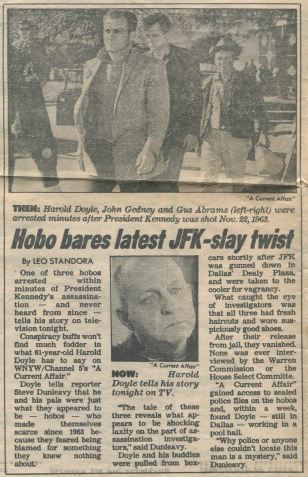
In order to understand this you are going to have to review my considerable research, rather than look at a few lines of text, as you are accustomed to doing on the Internet.

The first set of three tramps were arrested almost immediately after the assassination. The police radio: "Patrolman Whitman, contact Sawyer and notify him they are holding up a northbound freight train in the yard and want to shake it down before they go." Inspector J. Herbert Sawyer of the Dallas Police Department told the HSCA "he then organized a group of law-enforcement officers from the Dallas Police Department, the FBI, and Sheriff's Office, instructing them to find witnesses and possible suspects. These witnesses were brought to the Sheriff's Office. Inspector J. Herbert Sawyer had also sent a team to search the railroad yards, as there were reports that shots might have come from that direction...He recalls his men finding the three hobos in a boxcar. Sawyer did not personally interrogate these men, but said that they did look like hobos." [HSCA Sawyer interview 5.24.78 Basteri] Note that this broadcast occurred shortly after the event since a posse had not yet been formed.
Lee Bowers recalled: "Since there was the possibility that someone could have...climbed aboard this freight primarily... I stopped the train and gave them a chance to examine it and to be sure that there was no one on it. As a matter of fact, there were three people on it who appeared to be winos, and perhaps were the most frightened winos I had ever seen in my life, since there were possibly 50 policemen with shotguns and Tommy guns and various other weapons shaking them out of these boxcars."
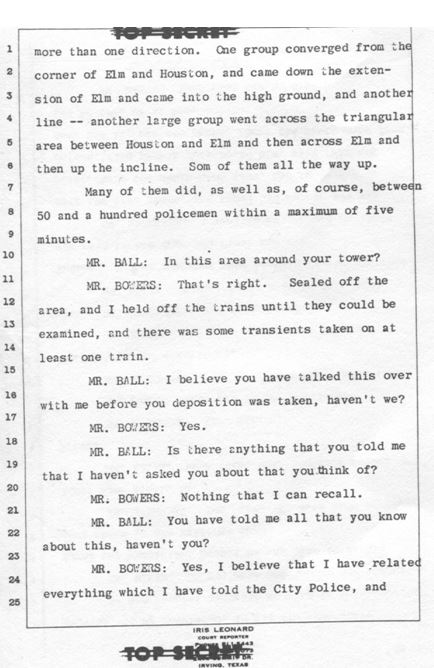
Ball: In this area around your tower? Bowers: That's right. Sealed off the area, and I held off the trains until they could be examined, and there was some transients taken on at least one train. Ball: I believe you have talked this over with me before you [sic] deposition was taken, haven't we? Bowers: Yes. Ball: Is there anything that you told me that I haven't asked you about that you can think of? Bowers: Nothing that I can recall. Ball: You have told me all you know about this, haven't you? Bowers: Yes...
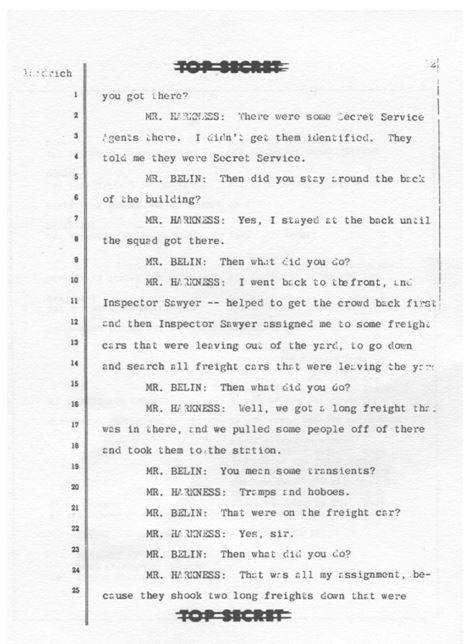
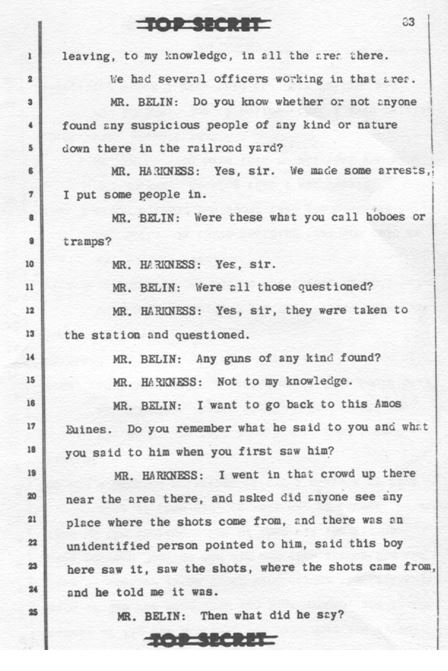
Harkness: We got a long freight that was in there, and we pulled some people off of there and took them to the station. Belin: You mean some transients? Harkness: Tramps and hoboes. Belin: That were on the freight car? Harkness: Yes, sir. Belin: Then what did you do? Harkness: That was all my assignment because they shook two long freights down that were leaving, to my knowledge, in all the area there. We had officers working in that area. Belin: Do you know whether or not anyone found any suspicious people of any kind or nature down there in the railroad yard? Harkness: Yes, sir. We made some arrests, I put some people in. Belin: Were these what you call hobos or tramps? Harkness: Yes, sir. Belin: Were all those questioned? Harkness: Yes, sir, they were taken to the station and questioned. Belin: Any guns of any kind found? Harkness: Not to my knowledge. Belin: I want to go back to this Amos Euines...
Since the police activity described by Bowers and Harkness took place immediately after the assassination it described the arrest of the first set of tramps.
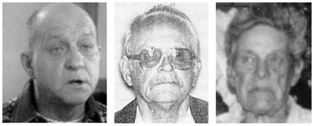
The three winos taken off the boxcar immediately after the assassination by numerous law enforcement officials were Harold Doyle (born December 8, 1930), John Forrester Gedney (born February 2, 1925; SS# 253-26-4169) and Gus Abrams. They were the first set of tramps to be picked up that day. They were not finger printed or photographed, but they were incarcerated and a record of their incarceration was made. The fact that their arrest records contained no fingerprints, booking numbers, or photographs was not unusual. Two other men who were picked up that day had similar arrest reports with no photographs or prints.
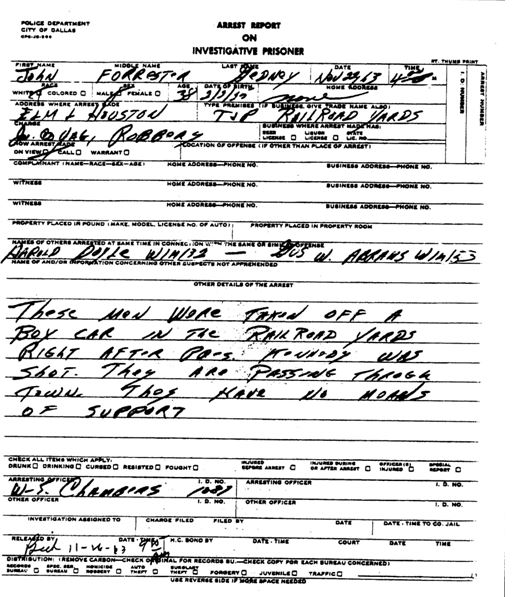
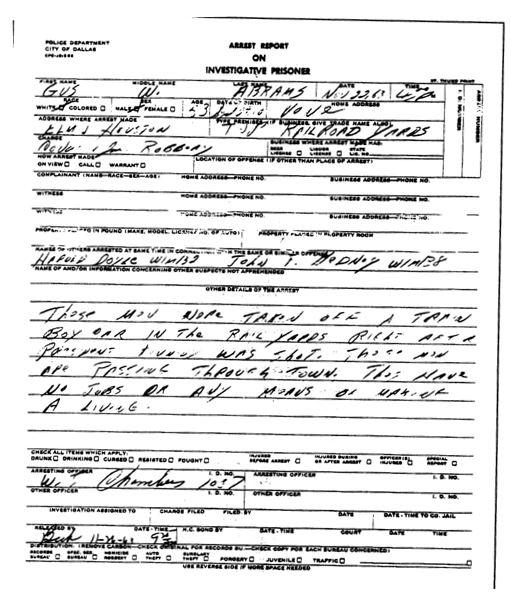
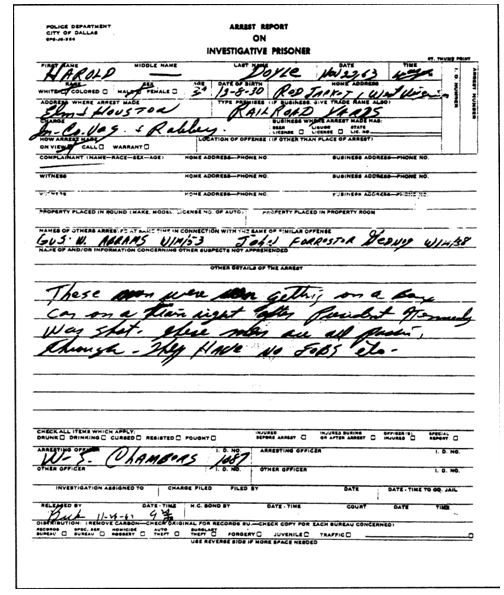
It was about 12:30 p.m. when Gus Abrams and the others were arrested in the Texas and Pacific railroad yards at Elm and Houston. At 4:00 p.m., Gus Abrams was charged with vagrancy and possible robbery: "These men were taken off a train boxcar in the railroad yards right after President Kennedy was shot. These men are passing through town. They have no jobs or any means of making a living." Officer W.E. Chambers filled out the arrest form. Missing from the form was a home address, I.D. number, arrest number and thumb print. The arrest of John Gedney also generated paperwork. Except for a different name and date of birth, his arrest record was identical with that of Gus Abrams. The last arrest record was on Harold Doyle, age 30, presumably the youngest of the three tramps. It was identical to the others, except in its description of the details of the arrest: "These men were seen getting on a boxcar in a train right after Kennedy was shot. These men are all passing through, they have no jobs..."
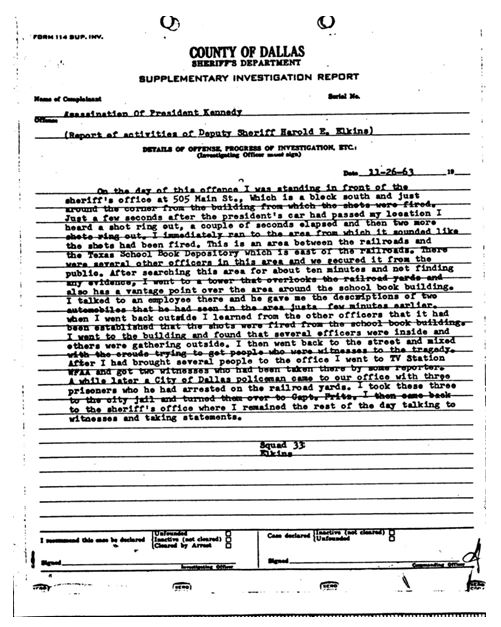
THE ELKINS DEPOSITION
COUNTY OF DALLAS SHERIFF'S DEPARTMENT
SUPPLEMENTARY INVESTIGATION REPORT
Name of Complaint: Assassination of President Kennedy.
Offense: (Report of activities of Deputy Sheriff Harold E.Elkins)
On the day of this offense I was standing in front of the Sheriff's office at 505 Main Street which is a block south and just around the corner from the building from which the shots were fired. Just a few seconds after the President's car had passed my location I heard a shot ring out, a couple of seconds elapsed and then two more shots ring out. I immediately ran to the area from which it sounded like the shots had been fired. This is an area between the railroad and Texas School Book Depository which is east of the railroads. There were several other officers in this area and we secured it from the public. After searching this area for about ten minutes and not finding any evidence, I went to a tower that overlooks the railroad yards and I talked to an employee there and he gave me the descriptions of two automobiles that he had seen in the area just a few minutes earlier. When I went back outside I learned from the other officers that it had been established that the shots were fired from the school book building I went to the building and found that several officers were inside and others were gathering outside. I then went back to the street and mixed with the crowds trying to get people who were witnesses to the tragedy. After I had brought several people to the office I went to TV Station WFAA and I got two witnesses who had been taken there by reporters. A while later a City of Dallas policeman came to our office with three prisoners who he had arrested on the railroad yards. I took these three to the City Jail and turned them over to Captain Fritz. I then came back to the Sheriff's Office where I remained the rest of the day talking to witnesses and taking statements.. [Elkins Sup. Rep. 11.26.63; WC Decker Exhibit 5323]
Sheriff Elkins did a number of things before receiving the three prisoners. This clearly indicated that a second set of tramps was arrested on November 22, 1963, since the first set of tramps were arrested and turned over to Detective Fritz immediately after the assassination. What happened that day was this: The Dallas Police continued to exhaustively search the freight on which Harold Doyle, John Gedney and Gus Abrams were found, as well as others in the yard. The search involved dozens of deputies, policemen, Alcohol, Tobacco and Firearms agents, Army Intelligence Agents etc. They found no one on board. Bowers was told to sound the all clear, and the trains left the yard. Several minutes later, at about 2:00 p.m., this police radio message was transmitted:
[49] C.R. Gilbreath: 10-4, 1:56 p.m. Dispatcher Hulse and McDaniel: 32 Dispatcher: On Shorecoast at the end of the N/S runway, report to location, 1:57 p.m. [61] Patrolmen G.W. Temple and R. E. Vaughn: We have information from the agent out here at T & P. Said that the train is stopped on the overpass, the triple overpass; that there was a person jumping at the ninth boxcar from the front engine. Said he is hiding in a car. Dispatcher: Is the train stopped there now? [61] Temple and Vaughn:
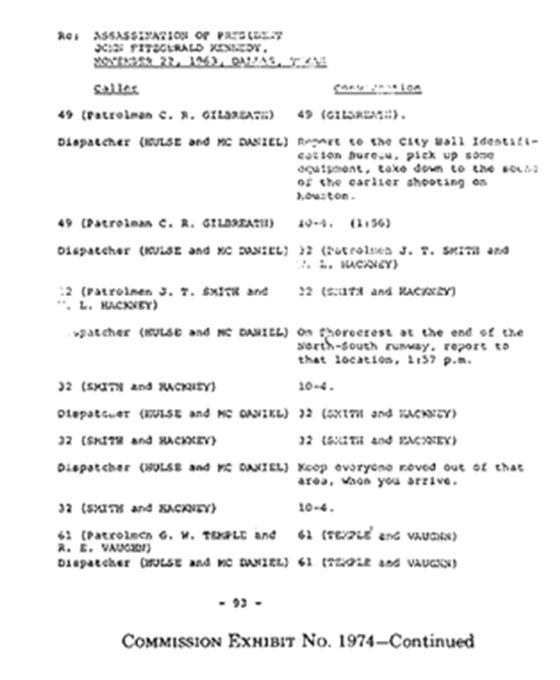
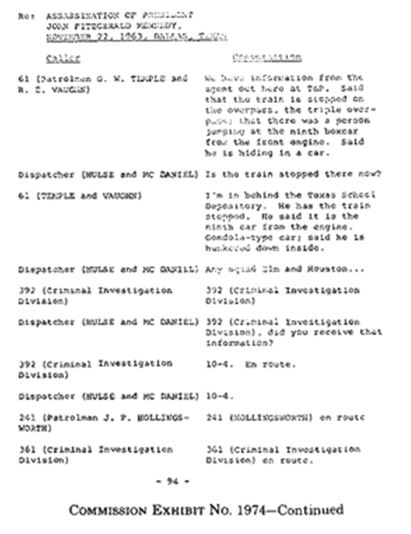
I'm in behind the Texas School Depository. He had the train stopped. He said it is in the ninth car from the engine. Gondola-type car; said he is hunkered down inside. Dispatcher: 393 (Criminal Investigation Division), did you receive information? 393 (Criminal Investigation Division): 10-4 En route. Hollingsworth: En route.
At about 2 PM, two hours after the coup, railroad tower man Lee Bowers had stopped the freight because he had seen someone "jumping at the ninth boxcar from the front engine." The second set of tramps, Hunt, Sturgis and Christ, who had cleverly hidden themselves to escape detection during the first search of the freight yard, were found in a boxcar by five Dallas Police Officers, not by 50 assorted law enforcement officials.
Hemming told this researcher:
Robert Hemming confirmed this.They went undetected because they were good. They were in the gondola car. And nobody could get up on the side of the gondola car to look in. They were looking in boxcars, not gondola cars. A gondola car, when you walk by it, appears to be full because the gravel or grain is up above the top level. It's like it's full, but there's a space in it, a bit of space along the sides. He wouldn't see them in a boxcar. He looked down from his tower and saw them in the gondola car. When Bowers saw the people in the gondola car he stopped the train. He called up on a radio in his base station. Every engineer carries a lunch box Motorola HT-100 VHF Radio. The hobos stole the radios so portables were used. There was one in the cab of this yardmule. This is not a freight train that goes cross country. This is a yardmule diesel engine that does short moving around the year. Maybe someone bailed out of this gondola because he realized he had been spotted from the tower and jumped in a box car, not necessarily on the freight that was being searched, but had no way out. My old man worked for the railroad. He was a conductor. I was raised around railroads, I used to ride the freights.
Inspector J. Herbert Sawyer assigned D. V. Harkness and a few other officers, "to some freight cars that were leaving the yard." D. V. Harkness was asked by this researcher: "About how long after the assassination did you search that train?" D.V. Harkness responded, "Oh, it was quite awhile, quite a time after that, they just didn't have anything leaving the freight yards till after they gave the all clear." When asked where the freight had been positioned during the assassination, D. V. Harkness replied: "It was in the railroad yards, right adjacent to the railroad yards when it happened." [tape rec. interview with Harkness] D. V. Harkness told the HSCA: "Either Inspector J. Herbert Sawyer or Lumpkin gave him an assignment to search the railroad cars and he helped roust the three tramps. He did not know their names or what happened to them."
In 1968, while investigating the assassination of Martin Luther King, FBI S.A. Bardwell Odum questioned Dallas Police Officer WILLIAM LEE BASS: "On May 15, 1968, William Bass, Identification Division, Dallas Police Department, identified the officer leading these three men as himself, and stated that on November 22, 1963, at which time photograph was taken, he, Roy Vaughn, and Marvin Wise had found three men in a boxcar about a mile from the Texas School Book Depository, down the railroad tracks. They brought them to the Dallas County Sheriff's Office and turned them over to an unknown deputy sheriff. He did not know the names of these individuals, and did not know if they were booked."
When William Bass was questioned by the Rockefeller Commission in 1975 he added, "The men were removed from a boxcar on the tracks in the vicinity of the Houston Street Viaduct. This area is approximately one half mile south of the Texas School Book Depository. They were all standing at one end of a boxcar." William Bass told the HSCA:
Somebody, maybe D. V. Harkness, said three men ran down the railroad yard and got into a grain car [the gondola car]. Me, Harkness, Wise, and Vaughn ran down the railroad tracks about one-quarter mile to the grain cars. Vaughn climbed up the ladder of one car and saw three men huddled in the corner of the freight car. Vaughn ordered the men out onto the ground and the men cursed at Vaughn. Vaughn then jacked a shell into the chamber of his shotgun, pointed it at the men, and ordered them out of the car. When the men got on the ground they were given a good pat-down for weapons - but none were found. The men were marched up the railroad tracks to Elm Street, across the front of the Texas School Book Depository, across the street to the County Jail, and turned over to a Deputy Sheriff (name unknown). He observed that the men had hobo type clothing on, but from the neck up were clean shaven and had good haircuts. The men did not say anything while being taken to the Sheriff's office. [HSCA 11.11.77 Rose]
Dallas Police Officer ROY EUGENE VAUGHN told the HSCA that on November 22, 1963, he was in a patrol car with G.W. Temple. After the assassination Roy Vaughn stayed in a patrol car next to the Texas School Book Depository, then took a suspect to the Sheriff's office:
Vaughn then returned to the Texas School Book Depository and he heard someone say that some men had jumped into a boxcar down by Union Station. He told a Sergeant in front of the Texas School Book Depository. Vaughn, Bill Bass, Marvin Wise, and another officer, ran down the tracks for three or four blocks to the grain cars near Union Terminal. Vaughn climbed up and went to the rear of the car. He looked into an open car [Hemming: "He climbed up the boxcar to look in the top of the gondola."] and saw three men at the opposite end of the car, kind of lying down. Vaughn pulled his revolver and ordered the men out of the car. Bass and Wise took the men to the Sheriff's office. Vaughn, and the other officers, rode the caboose back to the area of the Texas School Book Depository and got off. [Vaughn HSCA Depo.]
Sheriff Roy Vaughn was contacted on November 22, 1993. Buck Revell's story was circulating at this time to the effect that Harold Doyle, Gus Abrams and John Gedney were the tramps who had been photographed being marched through Dealey Plaza. Roy Vaughn:
I can't tell you if these guys were Harold Doyle, Gus Abrams and John Gedney. I don't know. A railroad man came down when I arrived on the scene. It was after lunch. 1:00 p.m., 2:00 p.m., 2:30 p.m., sometimes afterward. We were dispatched there. I was assigned to patrol in the South Dallas area. The dispatcher told us to report to that location - code three. And that's when I went. I was not there until sometime after the shooting occurred. This particular incident I am talking about was not immediately after the shooting, no. I was in between the Texas School Book Depository and what used to be a saw factory. And I did detain a man, a security guard brought him down. He had found that individual on the upper floors of the building. I took that man to the Dallas County Sheriff's Office that was directly across the street. Me and several others officers were involved in getting the people out of the open type car. If there was any arrests prior to these, I don't know. I can't say...I don't remember if they smelled. That was 30 years ago today. I was always under the impression there was no paperwork for 29 years then I heard about the arrest records [of Harold Doyle, John Gedney and Gus Abrams].
MARVIN LYNN WISE told the HSCA that the police radio dispatcher told him to go to the Texas School Book Depository.
He parked near the railroad tracks. He was sitting in his car and A man working in the railroad building waved at him. Wise and another officer (name forgotten) were told by the man that three men got into a boxcar about four or five hundred yards down the track. Wise, in company with Bill Bass, Vaughn and Middleton, went to the boxcars and took the men off the boxcar. Wise stated the men acted scared, and he could smell wine on the breath of one of them. Wise took the men over to the Sheriff's office and, while waiting to turn them over, asked the men for identification. Wise stated that he believes two of the men had documented IDs. He wrote the identification down on paper and put it in his hat. He turned the men over to the Sheriff's Office (Deputy's name unknown) and went back to his radio...Wise stated that he put the paper with the tramps' identification on it in his locker, where it remained for over a year. He cleaned his locker out, and just after that, people began asking him for information. But he had thrown it out.
Marvin Wise, 60, was contacted in June 1994. He wanted $1000 to tell his story. Marvin Wise:
The statement that I 'turned the men over to the Sheriff's Office (Deputy's name unknown) and went back to my radio' is not right. I did not go back to the car. I stayed with them. Number one, here's the deal: I was the junior man out of the five of us that was there. Everybody passed them on to me. Number two, how did they get from Sheriff Decker's up to Will Fritz? Will Fritz had them and had some kind of a record of having them up there. I never left them alone. That sure ain't right. I went to work that morning at 7:30 a.m. I was a patrolman for the Dallas Police Department assigned to South Dallas, which was predominately black then, and is today. Up till about 11:00 a.m. I had numerous little calls of disturbances and thefts. About 11:30 a.m. I got a call of a robbery in progress over on South Lamar. And so I proceeded that way. I went on and got there, and while I was out of the car and talking to the victims they called me, and I said: 'I'm at the scene, I'm talking to the victims.' The dispatcher said 'Get back on the air here. I want you to report at Elm and Lemar.' I said 'Well, I'm interviewing the victims.' He said, 'Disregard that call, don't take no more information, report on down there.' Well, by then, it's already after 12:30 p.m. and the shooting had happened. This was around 12:35 p.m. or 12:40 p.m. Right after the shooting. See, I didn't know it at the time, I had no idea. I just figured the parade was downtown. We all knew the President was coming to the downtown, but I was lucky enough that I didn't have to be there and stop traffic. Me and one other squad was the only squad cars in South Dallas on that day. I still didn't know anything. He said 'You have an order Code 3-71 to Elm and Lemar.' So here I go. I thought 'What in the hell has happened down there?' I flip over to the b.s. channel and I heard 'He's expired.' It dawned on me then that they'd had a big shooting. I knew right then something drastic had happened. So I arrived down there and God, there's mass chaos. The police officers, deputy sheriffs and plainclothesmen were around that School Book Depository. Well, I parked nearly 50 feet from it. There was a vacant space right along the little street there, which was being, Elm Street goes on across Houston and you go right on, right in front of the School Book Depository, and it dead ends right in there. I parked right there on the right. I got out and got my shotgun, I don't what I got it for. By then everybody's talking. There was so many officers there they don't have real control of everybody. 'Surround the building!' A sergeant that I did not know told me 'Stay right here.' So I'm standing there, I been there probably 20 minutes after I got there. A guy from the railroad tower had told someone he wanted to speak with an officer. One of them sergeants out there said 'Go talk to that guy in the tower out there. He seen something.' We all run out there. I go out there and talk, to find what the hell he wants. I was with Roy Vaughn when we went up in the tower, to see Bowers. And he says, 'Down there in that boxcar' and he points way down. I'm talking three or four hundred yards, it's a long ways down there. Maybe seven. I can only guess. He said, 'I saw three men running down from there. Looked like they were running from down into the area of the underpass. Just running along the railroad tracks. They started running, I don't know why they run, and they run up and jumped up in the boxcar.' And he points down there and he gives a pretty good indication of which boxcar it is. But at that time, the boxcar was slowly moving. But evidentially they were shooting cars up in there from all them tracks. And it stopped by the time we got in there. We're talking about 90 minutes after the assassination. I mean the whole area is swarming with FBI agents. This is when this occurred. So I run on down there. So we jump out, and so I go down and get the rest of the troops there, you know there's me, Roy Vaughn, Bill Bass, Middleton and Dave Harkness. So we all go down there to the boxcar, and when we got down there to the boxcar, everyone of us going down there had our thoughts about what it was. I wasn't the one that got them out. Maybe Vaughn. I talked to them in general conversation. Seems like one of those guys had a Midwest or and Eastern brogue. Not the old man. One of the others. After we got 'em and walked them away they didn't talk to nobody. No more conversation. I didn't try and interrogate them because I felt they were true winos. Their breath was unbelievable, smelling from wine. What we normally did with them, we had two options. If you couldn't find anything to put them in jail for, you could always city vag 'em. That's no visible means of support. Jails wouldn't hold all them people today.
We get them and bring them back up. All of 'em. Of course in the meantime they done shot our man across over in Oak Cliff. Anyway, I march them back up and across the street. It took about 15 to 20 minutes to walk them to Decker's. We got there at 2:30 p.m. As we march along the senior officers in the group, which is number one, Dave Harkness, leaves. Dave fell off and did not walk with us. He stopped over there, and then as we got on closer over there to Decker's there was one old sergeant standing on the street. I said 'What you want to do with these three guys here? They told us to go down there and get them out of the boxcar.' Two or three sergeants standing there and an inspector said 'Take them over to Sheriff Decker's office.' So we took them over. So the closer we get over there, the thinner the ranks get. It becomes me Roy Vaughn, Bill Bass. By the time we get inside there Bill Bass has split and left me with them and Roy Vaughn. Then Roy Vaughn jumps out. I'm junior man and I got five years. They leave me with them. So I present them to Decker. Decker takes them. They say 'You wait.' So I waited and I waited and I waited. Finally, they brought them back out there an hour or 45 minutes later. They send them back out there and say 'Take these three guys up to Will Fritz's office.' It's 3:30 p.m. Of course I knew where Will Fritz was. I walked those three guys out, put them in a city squad car. One set up front by me. Two in the back. We didn't have no cages back in those days. I drove them straight down, right in the basement. And took them right up, just me and those three guys. And these guys, none of them had no weapons on them, the only one that had anything was the old man. If you look at them pictures you'll see he's the only one. He's got a sack. In that sack was a little wrapped up washrag with a bar of soap in it, and what had been in it that I took out that none of the other officers knew, was a brand new bone handled knife that I knew he had stolen. Winos and bums, during that time, do not have it. He got it somewhere. He wouldn't have spent his last money to get him a brand new knife. So he took that, got it from some place, I have no idea where. But the thoughts running through my mind when they get through jacking around these guys is, 'I intend to put him in jail for theft.' And we could, back in those days, all you had to do was have something that was reasonable, a brand new knife, he's not working, no visible means of support. I was the one that got it out of there, nobody else handled that knife. So I take them to Will Fritz's office. And I walk in the office. I went through the whole story, where they come from. The boxcars. The whole bit. And they say 'Okay, sit down there and wait, Wise.' I knew everybody up there. I known them for years. They take the three in the back and I sit up front talking to one of the secretaries. I'm getting real impatient by now cause in those days you had to fill out an activity report at the end of the day on what you did. How many prisoners you arrested, how many tickets you wrote, how many calls you handled. Well, so far that day I had arrested nobody. So I'm thinking, look, I'm spending all this time, I've got to take credit for these guys in some kind of way. If anyone's gonna put them in jail, I sure as hell want to know, because my name ought to be on there. And Roy Vaughn's name on there and Middleton, who was an accident officer. They didn't care. Where they were at, they didn't have to worry about arrests, we did. So I'm waiting there and I thought, God, they're going to put these people in jail for something. I did not get to see Fritz. He was in his office. On any given day, you can't just walk in and see him. And there was no way that I was going to be able to take three winos in there and get to see him. One of his detectives who was milling around there, took these people after I told my lengthy story over once again, and told them all about them. It could have been Ernest Beck, it could have been anybody. There was so many of them in there. I don't even know if Will Fritz talked to them. I really don't. Beck was the number one man. When Fritz wanted anything done number one he'd call on Beck first. Beck was around there talking to everyone and chewing on a cigar. He may have took them. His name comes to mind, but I cannot say for sure that he was the one. I go in there, and I take them in there, and they kept them. They talked to them 45 minutes to an hour, maybe an hour and half. Then they come outside. This blew my mind. Here they come. 'Marvin, we don't need these. Take them back to Sheriff Decker." I looked at them and said, 'Do what?' They said 'Take them back to Sheriff Decker.' I never paid any attention to who it was. It could have been any number of people. I was so hot at the time. I sat out there 45 minutes to an hour, and it's nearly 4:00 p.m. I'm supposed to be off here. So they give 'em back to me. I was pissed. I looked at them and I said, 'Take them back to Decker? Man, these are goddamned bums here. You know, let's put them in jail, or throw them out on the street.' I was told 'Take them back to Decker, Marvin, I can only tell you what Captain Fritz said.' We go downstairs, all the way to the basement, right down there exactly where the man got shot on camera. Got in the car and drove straight back down there, and boy, I knew when I got down there with them they were going to be hot. I knew the Sheriff and his number one man and all them settin' around that office I don't know what they were doing, what part they had with it, but I knew they would ask, 'Why are you bringing these bums back down here to me, these winos?' I take 'em back down there. They won't even see me. I knock on the door and a man comes out and I says, 'Captain sent these back down, he wants me to turn them back over.' I did not know anybody down there at that time. Decker was the only one I knew, when I saw him and knew his name. I had to go through the whole damn story and all this and I said 'Will Fritz has sent them back down here.' He said, 'Wait.' There was no waiting room there. You didn't sit, you stood right there. That's where we stood, right there in that little old room. I called in and was told 'We're holding the day shift over at least three hours. You just stay with what you're doing until you get off.' Finally they come out and say 'We'll talk to them, take them in here.' I said, 'I'm gone.' That's the end of it. That's how I got out of it. I said, 'That's the end of it, I'm out of it, I don't wait. I've turned them over to you.' And I went out in the car, cleared, and got on the air. I got off about 5:00 p.m. I have no idea who I turned them over to in Decker's office. I never seen them since then. The ones I had was bums and winos, because of the smell, the appearance of their old clothes. They weren't ragged. Like they'd been slept in. One of them had on a pretty good coat, but when you sleep in these things, a new dress coat, it will wrinkle. They had a social security card, no drivers license. It was social cards we had to go by. One of 'em had no I.D. I can't say which one. I was the only one originally that got these peoples names. I wrote them down. Before, back in those days, we had the hot sheets when we left the detail room. Folded those up. Instead of putting them on the dash, most of the Dallas officers put them in their hats. Then when you answered a call real fast and when you jumped out of the car and you was in a hurry what you wrote down your notes on was in your hat. I put their names on that hot sheet and kept it for years. Then I did away with it. I don't remember any of those names. I later asked a supervisor if I could carry the tramps as an arrest. As far as I was concerned they were technically under arrest.
Marvin Wise was asked if the tramps were in a gondola or boxcar:
It was a gondola filled with grain. Vaughn and Bass got up and got 'em. I stayed down, I knew what they were, I knew exactly what we were going to get out of them cars. You knew when you been there so long and I was hacked for having to go down there, so was Roy Vaughn. We were all pissed about it, and we are still pissed today.
Doyle and Gedney never mentioned being shuttled back and forth between the Sheriff's office and the Dallas Police Department as Marvin Wise described. Clearly, there were two sets of tramps. In late September 1974, the FBI, acting on a request from FBI Director Clarence Kelley, located WILL FRITZ and showed him the tramp shots. He told the FBI that he did not
...recall having seen the three unidentified individuals in the above described photographs. He related that many people were taken to the Dallas County Sheriff's Office on November 22, 1963, by various law enforcement officers for questioning and undoubtedly many of them were released when eliminated from any implication, and such individuals were neither booked, photographed, nor finger printed. He added that he feels sure that if Hunt and Sturgis were interviewed on November 22, 1963, a record would have been made of their interviews and the Dallas County Sheriff's Office, Dallas Police Department, or Dallas FBI Office, would have a record of such interviews. He stated that it is possible the three unidentified men were interviewed, but without their names, there would be no way to definitely so state. When he viewed the photographs of Hunt and Sturgis, he stated he had no recollection of ever having seen or talked to either of them at any time on any matter. Captain Fritz concluded by saying that he is in full agreement with the findings of the Warren Commission."[FBI 62-109060-7136]
Will Fritz, born June 15, 1896, died in March 1984.
The FBI then checked with James Kitching, Chief of the Dallas County Sheriff's Office, Identification Division:
He advised that he had personally looked up the jacket and photograph of each person booked on November 22, 1963, and did not find anyone who bears a resemblance to the persons appearing in the photograph with Dallas Police Officer Bill Bass. He advised that this indicates that these persons were not booked, but that they may have been interviewed. He advised that a sort of screening office was operated by the Dallas County Sheriff's Office on November 22, 1963, and numerous persons were interviewed. He advised that without the names of the persons, it would be almost impossible to develop the names of the persons in the photograph.
Judging from the above testimony of the arresting officers, it is clear that considerable time elapsed between the assassination and the arrest of the tramps. Doyle and Gedney, by their own admission said they were picked up immediately after the assassination. There had to be two sets of tramps. The FBI interviewed W. E. CHAMBERS in February 1992 who advised
that though his name appears as the arresting officer, he did not have contact with the three individuals until they had already been brought down to the Dallas Police Department Headquarters. Chambers speculated that the three had probably been rounded up in a dragnet and were dropped off at the Station without any paperwork...He was assigned by his supervisor, Captain D.R. Jones, to initially watch the three individuals, and then later to interview them regarding the assassination. Chambers indicated that he was later advised by Jones that a suspect had been arrested in the murder of TIPPIT, and that the person was the main suspect in the assassination of President Kennedy. Chambers indicated that he then released the three hobos, without booking them into the jail. During the course of the interview, Chambers was shown copies of the 'Arrest Report on Investigative Prisoner' and commented that though he did not recall filling them out, he recognized them as being written in his own handwriting. Chambers further noted that the three individuals were held in the City Jail until November 26, 1963. Chambers noted that the report reflected that they were released by Officer Marvin Buch. Chambers could provide no explanation as to how the three ended up in the jail facility. Chambers further added that because the reports bore no arrest numbers he believed there would be no record of them being booked into jail. As a result of the interview with Chambers, Dallas will attempt to locate and interview R.C. Wagner, Detective William Grinell, Captain Jones, and Marvin Buch. Dallas will attempt to determine whether or not any jail records exist regarding the incarceration of Gus Abrams, Harold Doyle and John Gedney, to include the mechanism by which the 'Arrest Report on Investigative Prisoner' were transferred to the City Archives section in 1989. Dallas will obtain photographs of the three individuals and display them to Officer Chambers in an attempt to determine whether or not they were the three hobos he interviewed on November 22, 1963. The same photographs will be displayed for the purpose of attempting to identify the uniformed officers accompanying the three. Dallas will provide copies of the aforementioned photographs to Portland and Tampa in order to have Harold Doyle and John Gedney identify the photograph as depicting them on November 22, 1963. Both have made reference to the photographs to the interviewing agents, but have not been presented with the photographs to positively confirm that they are the individuals depicted. [FBI 62-109060-8301]
Contacted by telephone, W. E. Chambers, one of the arresting officers, denied his role in arresting the tramps:
Retired Dallas Police Officer Ernest Beck, credited with releasing all five hobos, stated: "I don't know, I don't know. I don't remember anything about that time...it was so long ago."You mean all that stuff in the news about the tramps? They got that wrong. My name is on the document, but it is wrong, I never questioned them. I might have seen them, I don't remember. I signed the reports, but there was some mistake. I don't like discussing this with strangers.
So there we have it. The CIA pulled the wool over the American public's eyes when it came to the identity of the mystery tramps. My research will never get as much media play as the CIA false news story did but that's the power of the CIA v. A. J. Weberman.